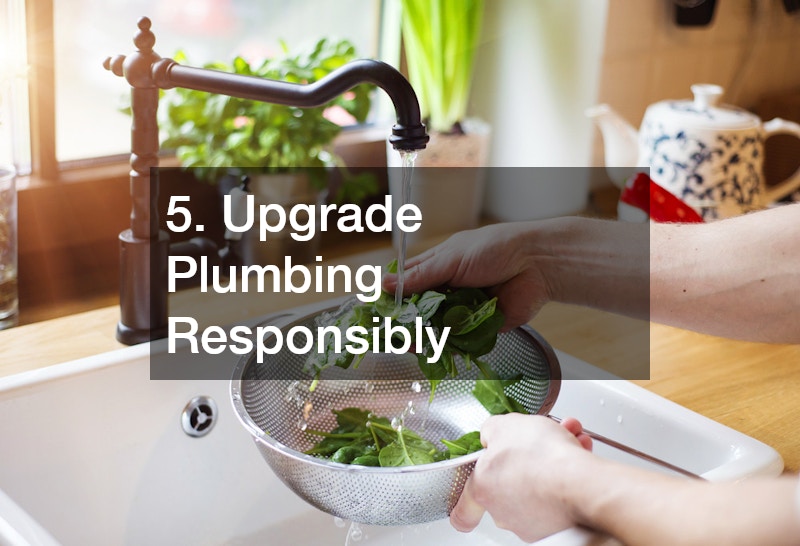Kitchen renovations are among the most impactful home improvements, but they can also generate a surprising amount of waste and environmental strain. From discarded appliances and cabinetry to outdated fixtures and countertops, the remodeling process can inadvertently harm the planet if not carefully planned. For homeowners committed to low-waste living, every decision—from material selection to labor and disposal—matters.
Eco-friendly kitchen renovations focus on minimizing waste, using sustainable materials, and extending the life of existing components whenever possible. This approach not only benefits the environment but often saves money, increases durability, and creates a healthier, more efficient cooking space. By adopting a strategic, low-waste mindset, homeowners can reduce landfill contributions, lower their energy consumption, and create a kitchen that aligns with their values.
In this guide, we explore ten practical, eco-friendly ideas for renovating your kitchen. Each section includes actionable tips for reducing waste, improving sustainability, and ensuring your renovation is both functional and environmentally responsible.
1. Donate or Recycle Old Kitchen Items

Before beginning a remodel, it’s essential to address the items being removed. Instead of sending old cabinets, appliances, or fixtures to the landfill, consider junk hauling services that specialize in responsible disposal and recycling. Many of these companies sort items for repurposing, recycling metals, plastics, and electronics, reducing environmental impact significantly.
Homeowners can also participate in local donation programs. Old appliances or gently used kitchenware can be donated to charities, shelters, or schools, extending the lifespan of items that might otherwise go to waste. Even textiles such as oven mitts, towels, or aprons can be redirected through cash for clothes thrift shops, ensuring nothing ends up in a landfill unnecessarily.
Taking the time to sort and responsibly dispose of old items also helps declutter your space before renovation begins. By planning for eco-conscious removal, homeowners create a clean and organized work area, which makes the remodeling process more efficient. Thoughtful management of old materials is the first step toward a truly low-waste renovation.
Furthermore, repurposing materials within your home can reduce costs. Cabinet doors, drawer fronts, or hardware may be reused in other rooms or outdoor projects. Even old countertops, if still in good condition, can serve as work surfaces for hobbies or outdoor kitchens. Every item salvaged represents a step toward reducing environmental impact and supporting sustainable living.
2. Use Sustainable Materials for Cabinets
Cabinets are a central feature of any kitchen, and choosing sustainable options can greatly reduce the environmental footprint of a renovation. Custom cabinetry made from responsibly sourced wood, reclaimed timber, or recycled materials is a smart choice. These cabinets not only minimize deforestation but often feature finishes that are low in volatile organic compounds (VOCs), promoting healthier indoor air quality.
Beyond material choice, custom cabinets are measured and crafted to fit your space precisely, which minimizes waste generated during the cutting and assembly process. Where possible, consider refurbishing existing cabinetry by repainting or replacing fronts and hardware instead of a full replacement. This approach significantly reduces the volume of material sent to landfills.
Working with experienced kitchen contractors ensures that your cabinets are installed efficiently, reducing mistakes and additional material waste. Professionals can also advise on designs that maximize storage, reduce clutter, and incorporate eco-friendly hardware like recycled metal handles or sustainably sourced hinges.
Custom cabinetry also allows homeowners to think long-term about functionality. Cabinets designed for durability and adaptability can evolve with changing needs, minimizing the likelihood of future replacements. By combining sustainable materials with expert installation, homeowners achieve a kitchen that is both environmentally responsible and practical for daily use.
3. Choose Energy-Efficient Appliances

Kitchen appliances are among the most resource-intensive components of a renovation. Upgrading to energy-efficient models reduces electricity and water consumption, saving money while lowering environmental impact. Look for appliances with ENERGY STAR certifications or other eco-friendly labels, which guarantee reduced energy use and improved performance.
Before purchasing new appliances, consider whether existing units can be repaired rather than replaced. Scheduling appliance repair for malfunctioning refrigerators, ovens, or dishwashers can extend their lifespan, preventing unnecessary manufacturing demand and reducing waste. Minor repairs, like replacing seals or fixing temperature controls, can make older appliances function almost like new.
Proper placement and installation of appliances also contribute to efficiency. Ensuring that refrigerators are not near heat sources or that dishwashers are correctly connected can reduce energy and water consumption. Over-ordering or replacing appliances that still work perfectly increases both environmental impact and household costs unnecessarily.
Finally, consider the end-of-life plan for old appliances. Donate or recycle units responsibly to keep metals and plastics out of landfills. By thoughtfully managing appliance selection, repair, and disposal, homeowners combine sustainability with practicality, ensuring a low-waste, energy-efficient kitchen renovation.
4. Eco-Friendly Countertop Options
Countertops are both practical and decorative, and the materials you choose can have a large environmental impact. Conventional countertops like granite and marble often involve energy-intensive quarrying and transportation. Eco-friendly alternatives, including recycled glass, reclaimed wood, bamboo, and composite materials, reduce resource consumption while offering durability and aesthetic appeal.
When shopping for countertops, consider options that require minimal finishing chemicals. Low-VOC adhesives and sealants protect indoor air quality, making your kitchen healthier for daily use. Bamboo is fast-growing and highly renewable, while reclaimed wood or recycled glass diverts materials from landfills. These sustainable choices align with low-waste renovation principles and add unique character to your kitchen.
Installation should be approached carefully to avoid unnecessary waste. Salvaging old countertops for other purposes, such as outdoor prep areas or work surfaces, further reduces the environmental footprint. Professional installers help ensure precise measurements and efficient placement, minimizing leftover materials that might otherwise be discarded. Choosing long-lasting, eco-friendly countertops enhances the kitchen’s appearance, reduces maintenance needs, and supports your broader sustainability goals. In the long term, investing in responsible countertop materials prevents frequent replacements and contributes to a durable, low-waste kitchen renovation.
5. Upgrade Plumbing Responsibly

Efficient plumbing reduces water waste and protects your kitchen from long-term damage. Leaky faucets, outdated pipes, and inefficient water fixtures can waste hundreds of gallons annually. Installing low-flow faucets, aerators, and modern sinks ensures that your kitchen uses water efficiently without sacrificing performance.
Engaging licensed plumbing services is essential to ensure all installations meet local codes and function correctly. Skilled professionals can detect potential problem areas, such as aging pipes or poor connections, and address them before they lead to leaks or water damage. Properly installed systems not only save water but also reduce the likelihood of costly repairs later.
Scheduling a drain cleaning service before renovations helps keep pipes clear and reduces the risk of clogs during construction. Clear drains minimize the chance of backups that could damage floors or cabinetry and prevent disruptions during the remodel. Routine maintenance also extends the lifespan of your plumbing system, further reducing waste and the need for premature replacements.
By thoughtfully upgrading plumbing, homeowners contribute to water conservation, prevent damage, and support a low-waste renovation. Efficient systems combined with professional installation create a functional kitchen that remains sustainable and cost-effective over the long term.
6. Optimize Lighting and Electric Efficiency
Lighting affects both the functionality and sustainability of a kitchen. Energy-efficient lighting solutions, such as LED bulbs, task lighting, and smart controls, can significantly reduce electricity use while providing well-distributed illumination for cooking and entertaining. Natural light integration also helps minimize reliance on electric lighting during daytime hours.
Hiring licensed electric services ensures that wiring and installations meet safety codes and operate efficiently. Professionals can recommend optimal fixture placement, smart switches, or automation systems to reduce energy waste. Properly installed circuits prevent overloads and allow homeowners to maximize the efficiency of their kitchen lighting without compromising performance.
Replacing outdated lighting components not only reduces energy consumption but also extends the lifespan of fixtures. Less frequent replacement means fewer discarded materials, supporting a low-waste approach. Combining efficient lighting with thoughtful design ensures the kitchen remains functional, visually appealing, and environmentally responsible. Long-term, energy-efficient lighting contributes to lower utility bills and aligns with sustainable living principles.
7. Incorporate Low-Waste Flooring
Flooring plays a major role in both a kitchen’s durability and environmental impact. Conventional flooring materials often rely on virgin resources and short lifespans, leading to frequent replacement and waste. Eco-friendly alternatives such as reclaimed wood, bamboo, cork, and recycled tiles provide durability, style, and sustainability.
Working with professional kitchen contractors ensures precise installation, which minimizes leftover material waste. Misaligned tiles or uneven boards often result in discarded pieces, so careful planning and measurement are crucial. Proper care and maintenance further extend the lifespan of eco-friendly flooring, reducing the frequency of replacements.
Durable flooring options that are easy to clean and maintain support a low-waste lifestyle by preventing premature wear and tear. Avoiding short-lived synthetic materials also minimizes environmental impact. By choosing high-quality, sustainable flooring and combining it with expert installation, homeowners achieve a kitchen that is both functional and eco-conscious, providing a solid foundation for a long-lasting, low-waste renovation.
8. Manage Renovation Waste
Waste management is a critical component of any low-waste kitchen renovation. During remodeling, debris can accumulate quickly, from old cabinetry and countertops to packaging materials and unused supplies. Engaging junk hauling services ensures that waste is sorted, recycled, or responsibly disposed of, keeping harmful materials out of landfills.
Temporary storage solutions, such as self storage facilities, allow homeowners to store salvageable materials for future use. Items like unused tiles, old hardware, or cabinets can be repurposed in other projects, which reduces waste and lowers renovation costs. Organizing waste also makes the construction site safer and more efficient, minimizing hazards and preventing damage to reusable materials.
Proper planning and management of renovation waste contribute directly to sustainability. It ensures that every piece of material is considered for reuse, donation, or recycling. By combining careful sorting with professional disposal services, homeowners can maintain a low-waste approach while completing their kitchen remodel efficiently.
9. Repurpose and Donate Materials
Repurposing and donating materials is a simple way to extend the lifecycle of items that might otherwise be discarded. Cabinets, countertops, fixtures, and even appliances may be suitable for resale or donation, giving them a second life while reducing landfill contributions. Programs like cash for clothes can accept kitchen textiles such as towels, aprons, or oven mitts, ensuring that every usable material is redirected from waste streams.
Repurposing materials within your home is another effective strategy. Drawer fronts, cabinet doors, or hardware can be adapted for other rooms, DIY projects, or outdoor use. Salvaging old countertops or shelving units for workshops, garages, or outdoor kitchens keeps materials out of landfills while saving money on new purchases.
These strategies not only promote sustainability but also teach homeowners to think creatively about their resources. By combining donation and repurposing efforts, each renovation becomes a model of low-waste living. A thoughtfully executed approach ensures that your kitchen is updated sustainably, with minimal environmental impact and maximal use of existing materials.
10. Plan for Long-Term Sustainability

A truly low-waste kitchen renovation is designed to last. Selecting durable finishes, high-quality cabinetry, energy-efficient appliances, and low-maintenance materials reduces the need for frequent replacements. Planning for long-term use ensures the kitchen remains functional, attractive, and eco-friendly for years to come.
Routine maintenance, including professional appliance repair, prolongs the life of key systems and prevents premature waste. Combining durable materials with regular upkeep minimizes replacement frequency, saving both resources and money. Sustainable habits, such as conserving water, managing energy use, and carefully maintaining countertops and flooring, further reinforce a low-waste lifestyle.
Long-term planning also involves considering adaptability. Cabinets, shelving, and layouts that can evolve with household needs prevent the need for additional renovations. By integrating sustainability into both design and daily use, homeowners create a kitchen that is not only stylish and functional but also environmentally responsible. This holistic approach maximizes the benefits of a low-waste renovation and ensures the kitchen supports a greener lifestyle for years to come.
Eco-friendly kitchen renovations save resources, reduce waste, and create a healthier home. From donating old items to choosing sustainable materials and appliances, each decision matters. Thoughtful material selection, expert installation, and responsible waste management make your kitchen beautiful, functional, and eco-friendly while protecting both the environment and your finances.
